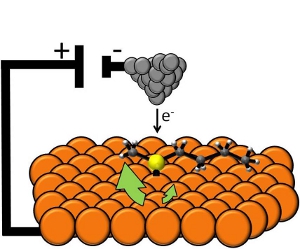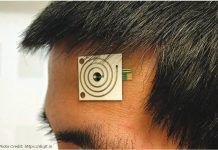
A Tufts research team has developed the world’s first single-molecule electric motor—which is a mere 1 nanometer across.
“The excitement is in the demonstration that you can provide electricity to a single molecule and get it to do something that’s not just random,” says team leader Charles Sykes, an associate professor of chemistry in the School of Arts and Sciences.
Single-molecule motors are not new, but until now they’ve been driven by either chemicals or light. A molecular motor powered by electricity has significant advantages over those other technologies, says Sykes. Likewise, using light to power molecular motors creates difficulties, because even very tightly focused light will hit many molecules at once.
With the scanning tunneling microscope, “we can land just on top of one molecule, measure it and spin it,” Sykes says. “It’s the ultimate way to do it.”Sykes and his colleagues used the metal tip of the microscope to provide an electrical charge to a butyl methyl sulfide molecule that had been placed on a copper surface. The molecule had a sulfur atom at the center and carbon atoms radiating off to form two arms, so to speak: four carbons on one side, one on the other. In subsequent experiments, such arms could potentially act as interlocking cogs or gears, and as one molecule is powered, it could turn or rotate others in sequence.
Sykes cautions that practical applications of the single-molecule electric motor are distant. But he imagines it could be used, for example, in sensing and medical test devices that involve tiny pipes. “At these small scales, friction of the fluid against the pipe walls increases, and covering the walls with motors may help drive the fluids along,” he says. Molecular electric motors may also be of use in nanoelectromechanical systems (NEMS). For instance, coupling molecular motion with electrical signals may allow scientists to build signal delay lines and nanoscale sensors.
Before realizing these potential applications, breakthroughs would have to be made in the temperatures at which electrically driven molecular motors operate. For the experiment that Sykes did at Tufts, the temperature surrounding the molecular motor had to be reduced to 5 Kelvin—a chilly minus 450 degrees F.
That’s because as temperatures rise, the motor spins much faster, far beyond the ability of the scientists to measure the rotations. At 100 Kelvin—or minus 279 degrees F—a molecular motor spins more than a million times per second. “It’s not that we couldn’t work at a higher temperature—it’s just that too much is happening,” says Sykes. “At that speed, it’s just a blur.”
At the colder temperature that the Sykes group used, the motor went through about 50 rotations per second, which were easily measured. But to prove that the motor was being driven by the electricity provided and that the movements were not just random, Sykes’ group had to track all those rotations. “For every single data point in the paper, about 5,000 of these [rotations] were counted,” Sykes says. “You collect data for five minutes, but it takes a week to analyze the data.”



